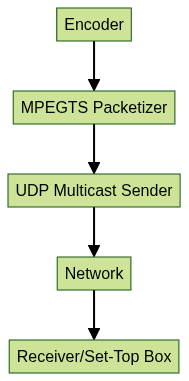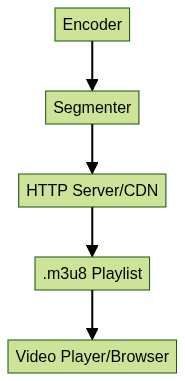Introduction
In 2025, streaming video content is a core feature of digital media platforms, powering everything from live sports to global news and entertainment. At the heart of every successful streaming solution lies a crucial choice: which protocol will deliver the best user experience and performance? Among the top contenders are MPEGTS (MPEG Transport Stream) and HLS (HTTP
Live Streaming
). Understanding the strengths, weaknesses, and inner workings of these protocols is essential for developers and architects tasked with building or upgrading streaming infrastructures. This article dives deep into "mpegts vs hls," comparing their workflows, adaptability, device support, and real-world use cases to help you make the right technical decision.Understanding MPEGTS (MPEG Transport Stream)
What is MPEGTS?
MPEGTS, or MPEG Transport Stream, is a digital container format standardized by ISO/IEC for transmitting audio, video, and data. Originally designed for broadcast applications such as DVB and ATSC, MPEGTS is renowned for its packet-based delivery and robust error correction—making it highly reliable for real-time streaming over unpredictable networks. Its design caters to uninterrupted transmission, even under poor network conditions, which is why it's widely used in IPTV, satellite, and cable broadcasting. For developers building interactive video experiences, integrating a
Live Streaming API SDK
can further enhance real-time delivery and audience engagement.How MPEGTS Works
MPEGTS operates on a continuous packet stream principle, commonly leveraging UDP multicast for efficient delivery to multiple endpoints. The stream is broken into small, fixed-size packets (typically 188 bytes), each containing payload data and error correction codes. This structure allows receivers to recover lost packets and maintain stream integrity. Its real-time, low-latency design makes it ideal for live TV and radio distribution.

Use Cases
- Broadcasting (DVB, ATSC)
- IPTV
- Professional video contribution links
Example: MPEGTS Stream Code Snippet
A typical MPEGTS stream URL might look like this:
1udp://239.0.0.1:1234
2Or, with FFmpeg, you could generate a MPEGTS stream:
1ffmpeg -re -i input.mp4 -c:v mpeg2video -f mpegts udp://239.0.0.1:1234
2Understanding HLS (HTTP Live Streaming)
What is HLS?
HLS (HTTP Live Streaming) is Apple’s adaptive, segment-based streaming protocol introduced in 2009. It has since become the de facto standard for web and mobile streaming, especially on Apple devices. HLS breaks video into small file segments (usually 2–10 seconds each), making it robust against network fluctuations and ideal for adaptive bitrate streaming. Its reliance on standard HTTP servers and CDNs makes HLS highly scalable and firewall-friendly. If your application also requires real-time communication features, consider integrating a
Video Calling API
to enable seamless video and audio interactions alongside your HLS streams.How HLS Works
HLS operates on a segmenting principle. The encoder slices the video into segments, and a manifest file (m3u8 playlist) indexes these chunks. Clients fetch segments over HTTP, enabling easy caching and adaptive bitrate selection based on network conditions. For developers interested in cross-platform streaming and communication, exploring options like
webrtc android
andflutter webrtc
can help extend compatibility to native mobile apps.
Use Cases
- OTT (Over-the-top) streaming services
- Live and on-demand web streaming
- Distribution to Apple devices
Example: HLS Playlist Code Snippet
A basic HLS playlist (.m3u8) might look like this:
1#EXTM3U
2#EXT-X-VERSION:3
3#EXT-X-TARGETDURATION:6
4#EXT-X-MEDIA-SEQUENCE:0
5#EXTINF:6.0,
6segment0.ts
7#EXTINF:6.0,
8segment1.ts
9#EXT-X-ENDLIST
10MPEGTS vs HLS: Side-by-Side Comparison
Protocol Structure and Delivery
The core difference in "mpegts vs hls" lies in their approach to data delivery. MPEGTS uses a packet-based model, typically over UDP and multicast, allowing real-time, continuous streaming. In contrast, HLS segments the stream into small files, delivered over standard HTTP—facilitating easy scaling via CDNs and making it firewall-friendly. For developers building cross-platform apps, solutions like
react native video and audio calling sdk
andjavascript video and audio calling sdk
can help unify streaming and communication features across devices.| Feature | MPEGTS | HLS |
|---|---|---|
| Data Unit | Packets (188 bytes) | Segments (2-10s files) |
| Transport Protocol | UDP (multicast/unicast) | HTTP (unicast, CDN-friendly) |
| Delivery Model | Push (real-time) | Pull (on-demand) |
Streaming Quality & Adaptability
Latency is a pivotal factor in the mpegts vs hls debate. MPEGTS is engineered for minimal delay, making it optimal for live events and real-time applications. HLS, however, introduces additional latency due to segment buffering, but it compensates with adaptive bitrate streaming—dynamically adjusting quality based on network conditions.
- MPEGTS: Constant bitrate, minimal latency (sub-second possible), but not adaptive.
- HLS: Higher latency (3–30 seconds typical), but supports adaptive streaming for smooth viewing across changing networks.
Device & Player Compatibility
Device and browser compatibility is often the deciding factor in protocol choice.
| Platform/Device | MPEGTS Support | HLS Support |
|---|---|---|
| Smart TVs | Yes | Yes |
| Set-Top Boxes | Yes | Yes |
| Desktop Browsers | Limited | Excellent (esp. Safari) |
| Mobile (iOS/Android) | Rare (native) | Excellent |
| OTT Devices | Yes | Yes |
- HLS: Natively supported on all Apple devices, most modern browsers, and media players.
- MPEGTS: Broadly used in professional broadcast and IPTV hardware, but limited browser support without plugins.
Security & Analytics
- Encryption & DRM: HLS supports AES-128 encryption and integration with major DRM systems (FairPlay, Widevine, PlayReady). MPEGTS can be encrypted at the transport level (e.g., scrambling) but lacks standardized DRM support.
- Analytics: HLS, as an HTTP-based protocol, is more amenable to integration with web analytics and QoS monitoring platforms.
Pros and Cons of MPEGTS and HLS
MPEGTS
Pros:
- Ultra-low latency, real-time delivery
- Reliable over lossy networks (error correction)
- Well-suited to multicast/broadcast environments
- Mature, stable protocol with widespread professional adoption
Cons:
- Limited browser and mobile support
- No native adaptive bitrate
- Higher barrier to internet-scale distribution (compared to HTTP-based protocols)
HLS
Pros:
- Adaptive bitrate streaming for smooth playback
- Excellent device/browser compatibility (esp. Apple ecosystem)
- HTTP/CDN-friendly and scalable
- Supports encryption and industry-standard DRM
Cons:
- Higher latency due to segment buffering
- Not optimal for real-time, sub-second streaming
- Slight startup delay (initial buffering)
When to Choose:
- MPEGTS: Best for closed-network, real-time, broadcast/IPTV use cases.
- HLS: Optimal for OTT, web, and multi-device delivery where adaptability and reach matter.
Real-World Implementation Scenarios
IPTV, Broadcasting, and OTT
- IPTV/Broadcasting: Operators choose MPEGTS for its ultra-reliable, low-latency delivery over managed networks. For example, a telco might use MPEGTS over multicast to deliver hundreds of live TV channels to set-top boxes with minimal delay.
- OTT/Web Streaming: Streaming services like Netflix, Hulu, and Apple TV+ rely on HLS for reach and adaptability. HLS enables seamless delivery to web browsers, mobile devices, and smart TVs through HTTP and CDNs. For those building video conferencing or live interaction features, integrating a robust
Video Calling API
can help deliver high-quality, real-time communication alongside your OTT streams.
Case Study: Live Sports
A major sports broadcaster streams matches via MPEGTS for cable subscribers (low latency), while offering the same content via HLS on their OTT app for mobile and web viewers—ensuring both reliability and broad compatibility.
How to Choose: Decision Checklist
Here’s a practical "mpegts vs hls" checklist for developers and architects:
- Target devices: Need browser/mobile support? Favor HLS.
- Latency requirements: Need sub-second delivery? MPEGTS is optimal.
- Network environment: Closed broadcast/IPTV? MPEGTS. Internet/public web? HLS.
- Scalability: Need CDN/distributed delivery? HLS excels.
- Security/DRM: Require advanced DRM? HLS supports more options.
- Adaptability: Expect variable bandwidth? HLS’s adaptive bitrate is key.
- Analytics: Need detailed viewing stats? HLS integrates easily with web analytics.
Conclusion
Choosing between MPEGTS vs HLS in 2025 depends on your unique streaming goals. MPEGTS remains the gold standard for professional, low-latency, real-time broadcasting and IPTV. HLS, meanwhile, reigns supreme for scalable, adaptive, and device-agnostic OTT delivery. Carefully assess your environment, audience, and technical needs to make the right protocol call—ensuring your streams are both robust and ready for the future. If you're ready to build your own streaming or communication solution,
Try it for free
and start experimenting with the latest APIs and SDKs for your next project.Want to level-up your learning? Subscribe now
Subscribe to our newsletter for more tech based insights
FAQ